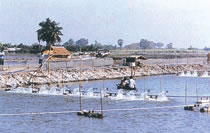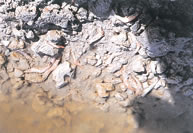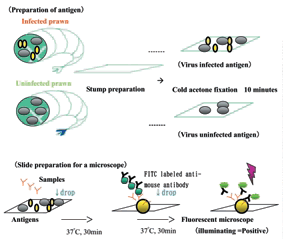Diagnosis and prevention of viral diseases occurring in cultured Shrimp
Description
[Objectives]
In recent years, prawn culture has developed rapidly as an industry in Southeast Asia. However, the production of cultured prawns has decreased markedly as a result of serious viral disease outbreaks such as White Spot Syndrome Virus (WSSV) disease. Therefore, in order to ensure stable production of cultured products, it is essential that preventive countermeasures against viral diseases be adopted. The aim of this study is the development of serological diagnosis and disinfection methods for the prevention of prawn viral diseases.
[Results]
Serological diagnosis using monoclonal antibodies is one of the most rapid and accurate methods. The production of monoclonal antibodies involves four steps (Fig. 1) ; the preparation of virus antigen, mouse immunization, cell fusion of spleen cells with myeloma cells, and then screening and culture of the hybridoma cells for producing the monoclonal antibodies. As a result, a few strains producing virus-specific antibodies are obtained from more than 100 strains of hybridomas. These monoclonal antibodies are thereafter used in the diagnosis of WSSV.
Viral inactivation against WSSV was tested using chemicals such as formalin and halogenous disinfectants, including sodium hypochlorite and IsodineR. The virus was inactivated with concentrations above 0.25% for formalin, 0.5 ppm for chloride, and 1.25 ppm for povidone-iodone. The data from these experiments indicated that halogenous disinfectants induced an effective inactivation even at lower concentrations.
From these studies, the diagnosis and disinfection techniques for WSSV should enable the prevention of pathogen intrusion into aquaculture farms in Southeast Asia.
Figure, table
-
Photo 1. Aquaculture pond for prawn farming in Malaysia. -
Photo 2. Mass mortality of prawns due to viral disease in Malaysia. -
Fig. 1. Screening methods for antibody using indirect immunofluorescence technique.
- Affiliation
-
Japan International Research Center for Agricultural Sciences Fisheries Division
-
National Research Institute of Aquaculture
- Classification
-
Technical A
- Term of research
-
FY2001 (FY1997-2001)
- Responsible researcher
-
OSEKO Norihisa ( National Research Institute of Aquaculture )
- ほか
- Publication, etc.
-
B. C. Kua, N. Oseko, V. Palanisamy and T. T. Chuah (1999): Disease of cultured tiger shrimp (Penaeus monodon) from farm in Sarawaku. Proceedings of the "First National symposium on aquaculture", Penang, Malaysia, 20.
T. T. Chuah, N. Oseko and V. Palanisamy (2000): Shrimp disease in Malaysia's mangrove ponds. Proceedings of JIRCAS International Workshop on "Brackish Water Mangrove Ecosystem. - Productivity and Sustainable Utilization - ", Tsukuba, 131-135.
- Japanese PDF
-
2001_20_A3_ja.pdf898.18 KB
- English PDF
-
2001_17_A4_en.pdf115.56 KB



